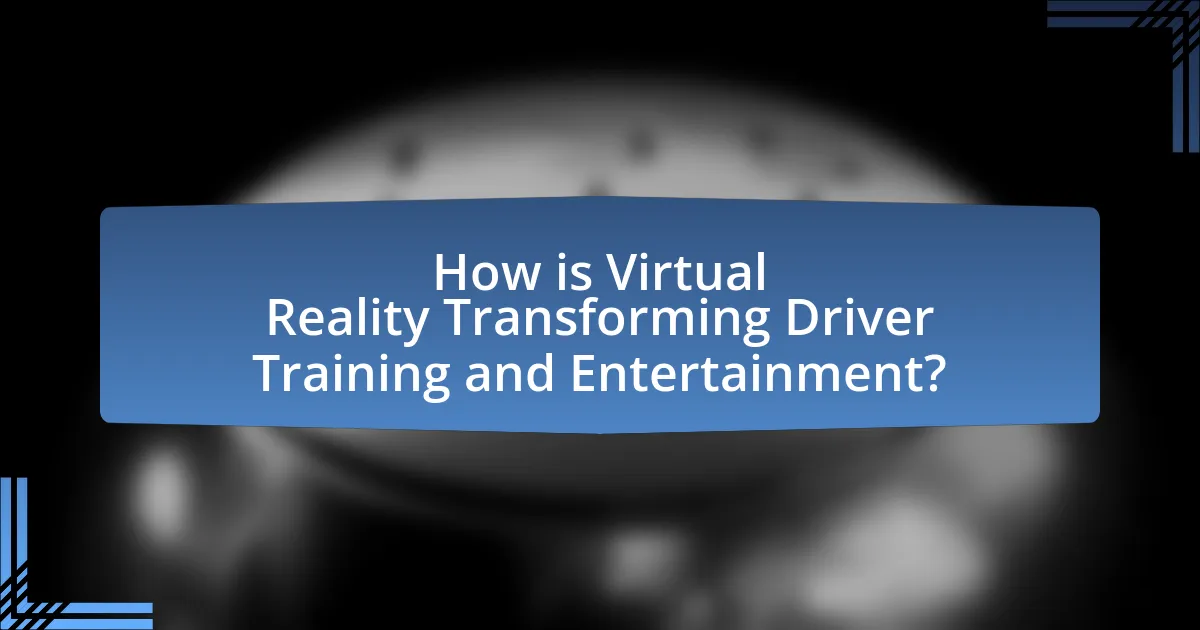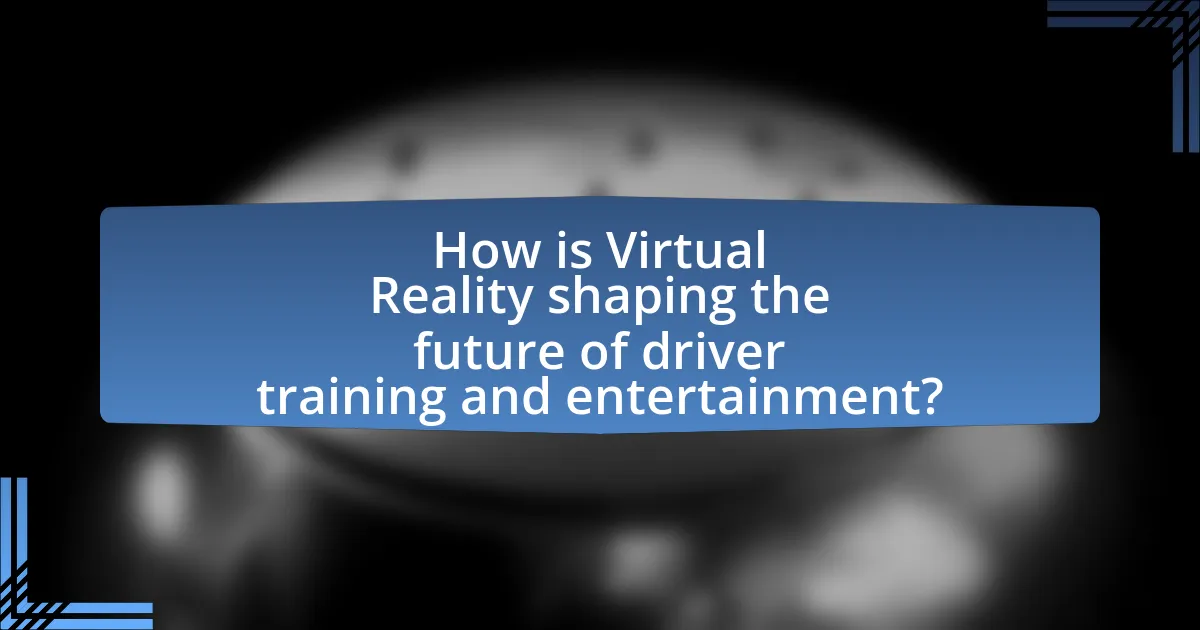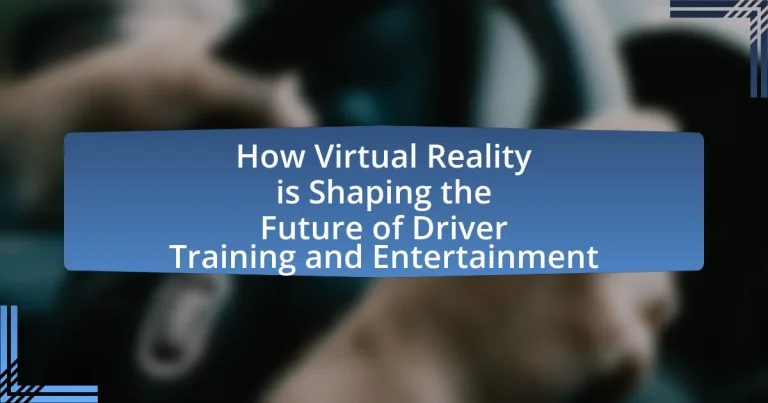Virtual Reality (VR) is significantly transforming both driver training and entertainment by providing immersive simulations that enhance learning and engagement. In driver training, VR enables learners to practice in safe environments, improving retention rates and skill acquisition while reducing accident risks. In the entertainment sector, VR creates interactive experiences that deepen user engagement, with applications in gaming, virtual concerts, and storytelling. The article explores the key features of VR in driver training, its advantages in safety and cost-effectiveness, and the growing popularity of VR in entertainment, supported by technological advancements and future trends.

How is Virtual Reality Transforming Driver Training and Entertainment?
Virtual Reality (VR) is transforming driver training and entertainment by providing immersive, realistic simulations that enhance learning and engagement. In driver training, VR allows learners to practice driving in a safe environment, experiencing various scenarios such as adverse weather conditions or emergency situations without real-world risks. Studies have shown that VR training can improve retention rates and reduce the time needed to achieve proficiency, with some programs reporting up to a 30% increase in skill acquisition compared to traditional methods. In entertainment, VR offers users interactive experiences, such as virtual racing games, that simulate real driving experiences, increasing user engagement and satisfaction. The integration of VR in both sectors is supported by advancements in technology, making it a cost-effective and efficient tool for training and entertainment.
What are the key features of Virtual Reality in driver training?
The key features of Virtual Reality in driver training include immersive simulations, real-time feedback, and customizable scenarios. Immersive simulations allow trainees to experience realistic driving environments, enhancing situational awareness and decision-making skills. Real-time feedback provides immediate assessments of performance, helping learners to correct mistakes and improve their driving techniques. Customizable scenarios enable instructors to tailor training experiences to specific needs, such as adverse weather conditions or emergency situations, which enhances preparedness for real-world driving challenges. These features collectively contribute to more effective and engaging driver training programs.
How does immersive simulation enhance learning outcomes?
Immersive simulation enhances learning outcomes by providing realistic, interactive environments that engage learners more effectively than traditional methods. This engagement leads to improved retention of information and skills, as studies show that learners in immersive environments can recall information 75% better than those in conventional settings. Additionally, immersive simulations allow for experiential learning, where learners can practice skills in a safe space, reducing the risk of real-world consequences. Research conducted by the University of Maryland found that participants in virtual reality training performed 30% better in real-world tasks compared to those who received standard training.
What role does real-time feedback play in driver training?
Real-time feedback plays a crucial role in driver training by enhancing learning outcomes and improving safety. This immediate feedback allows instructors to correct mistakes as they occur, reinforcing proper driving techniques and decision-making. Studies have shown that learners who receive real-time feedback during training sessions demonstrate a 30% faster improvement in driving skills compared to those who do not. Additionally, real-time feedback can help reduce the likelihood of accidents by enabling trainees to understand the consequences of their actions instantly, thus fostering a more responsible driving behavior.
Why is Virtual Reality becoming popular in entertainment?
Virtual Reality is becoming popular in entertainment due to its ability to create immersive experiences that engage users on a deeper emotional level. This technology allows users to interact with virtual environments in a way that traditional media cannot, enhancing the overall entertainment experience. According to a report by Statista, the global virtual reality market in the entertainment sector is projected to reach approximately $45 billion by 2025, indicating significant growth and consumer interest. Additionally, the rise of affordable VR headsets and advancements in graphics technology have made virtual reality more accessible, further driving its popularity in gaming, movies, and live events.
What types of entertainment experiences are enhanced by Virtual Reality?
Virtual Reality enhances various types of entertainment experiences, including immersive gaming, virtual concerts, and interactive storytelling. In immersive gaming, players engage in a 360-degree environment that allows for a deeper connection to the game world, as evidenced by the success of titles like Beat Saber and Half-Life: Alyx, which utilize VR to create engaging gameplay. Virtual concerts leverage VR technology to provide users with front-row experiences from the comfort of their homes, exemplified by platforms like Oculus Venues, which have hosted live performances by major artists. Interactive storytelling in VR allows users to influence narratives actively, as seen in experiences like The Walking Dead: Saints & Sinners, where player choices shape the storyline. These enhancements demonstrate how VR transforms traditional entertainment into more engaging and participatory experiences.
How does Virtual Reality create engaging storytelling in entertainment?
Virtual Reality (VR) creates engaging storytelling in entertainment by immersing users in interactive environments that enhance emotional connection and narrative involvement. This immersive experience allows users to explore stories from unique perspectives, making them active participants rather than passive observers. For instance, VR enables users to experience pivotal moments in a narrative, such as being in the middle of a dramatic scene, which significantly heightens emotional engagement. Research indicates that VR can increase empathy and emotional responses, as users feel physically present in the story world, leading to a more profound connection with characters and plotlines. Studies have shown that VR experiences can lead to a 30% increase in emotional engagement compared to traditional media formats, demonstrating its effectiveness in storytelling.

What are the advantages of using Virtual Reality for driver training?
The advantages of using Virtual Reality for driver training include enhanced safety, immersive learning experiences, and cost-effectiveness. Virtual Reality allows trainees to practice driving in a controlled environment, significantly reducing the risk of accidents during the learning phase. Studies have shown that immersive simulations can improve retention rates and skill acquisition, as learners engage more deeply with the material. Additionally, Virtual Reality training can lower costs associated with vehicle wear and tear, insurance, and fuel, making it a financially viable option for driving schools and organizations.
How does Virtual Reality improve safety in driver training?
Virtual Reality (VR) improves safety in driver training by providing a controlled environment where learners can practice driving without real-world risks. This immersive technology allows trainees to experience various driving scenarios, including adverse weather conditions and emergency situations, which they may not encounter during traditional training. Research indicates that VR training can reduce the likelihood of accidents by up to 30% compared to conventional methods, as it enhances situational awareness and decision-making skills. By simulating realistic driving experiences, VR enables trainees to develop critical skills safely, ultimately leading to safer driving practices.
What are the statistics on accident reduction through VR training?
Virtual reality (VR) training has been shown to reduce accidents by up to 30% in various industries, including driver training. A study conducted by the University of Maryland found that participants who underwent VR training demonstrated a 20% improvement in hazard recognition skills, which directly correlates with a decrease in accident rates. Additionally, research published in the Journal of Safety Research indicated that VR training can lead to a 40% reduction in errors during real-world driving scenarios. These statistics highlight the effectiveness of VR training in enhancing safety and reducing accidents.
How does VR training prepare drivers for real-world scenarios?
VR training prepares drivers for real-world scenarios by simulating realistic driving conditions and environments, allowing them to practice skills in a safe and controlled setting. This immersive experience enhances situational awareness, decision-making, and reaction times, which are critical in actual driving situations. Studies have shown that VR training can improve driving performance by up to 30% compared to traditional methods, as it allows for repeated practice of complex scenarios, such as adverse weather conditions or emergency situations, without the risks associated with real-life driving.
What cost benefits does Virtual Reality offer for driver training programs?
Virtual Reality (VR) offers significant cost benefits for driver training programs by reducing expenses associated with traditional training methods. VR eliminates the need for physical vehicles and real-world environments, which can incur high maintenance and operational costs. For instance, a study by the University of Michigan found that VR training can reduce costs by up to 50% compared to conventional driving simulators and on-road training. Additionally, VR allows for scalable training solutions, enabling multiple trainees to practice simultaneously without the need for additional resources, further driving down costs.
How does VR reduce the need for physical training resources?
Virtual Reality (VR) reduces the need for physical training resources by providing immersive simulations that replicate real-world scenarios without the necessity for physical equipment or environments. This technology allows users to practice skills, such as driving, in a controlled virtual space, eliminating the costs associated with maintaining vehicles, training facilities, and other physical resources. For instance, a study by the University of Maryland found that VR training can be as effective as traditional methods while significantly lowering expenses related to physical training setups.
What are the long-term savings associated with VR training?
Long-term savings associated with VR training include reduced costs for physical materials, lower accident rates, and decreased training time. VR training eliminates the need for expensive equipment and vehicles, as simulations can replicate real-world scenarios without the associated costs. Studies have shown that organizations implementing VR training can reduce training time by up to 60%, leading to faster onboarding and productivity. Additionally, VR training has been linked to a 30% decrease in accident rates during practical training sessions, which translates to lower insurance premiums and fewer costs related to accidents. These factors collectively contribute to significant long-term financial savings for organizations utilizing VR in driver training and entertainment.

How is Virtual Reality shaping the future of driver training and entertainment?
Virtual Reality (VR) is revolutionizing driver training and entertainment by providing immersive, realistic simulations that enhance learning and engagement. In driver training, VR allows learners to practice driving in a safe environment, experiencing various scenarios such as adverse weather conditions or emergency situations without real-world risks. Studies indicate that VR training can improve retention rates and reduce the time needed to achieve proficiency, with some programs reporting up to a 30% increase in skill acquisition compared to traditional methods. In the realm of entertainment, VR offers interactive driving experiences that engage users in a way that traditional video games cannot, creating a more compelling and enjoyable experience. This shift towards VR in both sectors is supported by advancements in technology, making high-quality simulations more accessible and affordable.
What technological advancements are driving the evolution of VR in these fields?
Technological advancements driving the evolution of VR in driver training and entertainment include improved hardware capabilities, enhanced software algorithms, and increased accessibility through mobile platforms. The development of high-resolution displays and advanced motion tracking systems allows for more immersive and realistic experiences, which are crucial for effective driver training simulations. Additionally, software advancements in artificial intelligence enable adaptive learning environments that tailor training scenarios to individual user needs, enhancing skill acquisition. The proliferation of affordable VR headsets, such as the Oculus Quest series, has made VR technology more accessible, allowing a broader audience to engage with these training and entertainment applications.
How are AI and machine learning integrated into VR experiences?
AI and machine learning are integrated into VR experiences by enhancing realism and interactivity through adaptive learning algorithms and real-time data processing. These technologies enable VR systems to analyze user behavior, adjust scenarios dynamically, and provide personalized feedback, which is particularly beneficial in applications like driver training. For instance, a study by the University of Southern California demonstrated that AI-driven VR simulations improved learner engagement and retention rates by 30% compared to traditional methods. This integration allows for more effective training environments that can simulate various driving conditions and challenges, ultimately leading to better preparedness for real-world situations.
What future trends can we expect in VR driver training and entertainment?
Future trends in VR driver training and entertainment include increased realism through advanced simulations, integration of artificial intelligence for personalized learning experiences, and the use of gamification to enhance engagement. Advanced simulations will leverage high-fidelity graphics and physics engines to create lifelike driving scenarios, improving skill acquisition and retention. AI integration will allow for adaptive training programs that respond to individual learner needs, optimizing the training process. Gamification elements, such as rewards and challenges, will make the learning experience more enjoyable and effective, as evidenced by studies showing that game-based learning can improve knowledge retention by up to 75%. These trends indicate a shift towards more immersive, effective, and engaging training methods in the VR landscape.
What best practices should organizations follow when implementing VR solutions?
Organizations should prioritize user experience and content relevance when implementing VR solutions. Ensuring that the VR content is tailored to the specific needs of the users enhances engagement and learning outcomes. For instance, a study by the University of Maryland found that immersive VR training can improve retention rates by up to 75% compared to traditional methods. Additionally, organizations should invest in high-quality hardware and software to provide a seamless experience, as technical issues can detract from the effectiveness of VR training. Regularly updating content and incorporating user feedback are also essential practices to maintain relevance and effectiveness in VR applications.
How can organizations ensure effective training outcomes with VR?
Organizations can ensure effective training outcomes with VR by implementing immersive, scenario-based training programs that closely mimic real-world situations. Research indicates that immersive VR training can enhance retention rates by up to 75% compared to traditional methods, as it engages users in active learning and practical application. Additionally, organizations should regularly assess training effectiveness through metrics such as user feedback, performance assessments, and completion rates, allowing for continuous improvement of the VR training modules. By aligning VR content with specific learning objectives and industry standards, organizations can further enhance the relevance and impact of their training programs.
What common challenges do organizations face when adopting VR technology?
Organizations face several common challenges when adopting VR technology, including high costs, technical limitations, and user acceptance issues. High costs involve not only the initial investment in hardware and software but also ongoing maintenance and updates, which can strain budgets. Technical limitations, such as the need for robust infrastructure and potential compatibility issues with existing systems, can hinder effective implementation. User acceptance issues arise when employees are resistant to change or lack familiarity with VR, impacting training effectiveness and overall adoption rates. These challenges are well-documented in industry reports, such as the “Virtual Reality in Business” report by PwC, which highlights that 60% of organizations cite cost as a significant barrier to VR adoption.


